|
|
Central-Colombia Trip 2004
Introduction
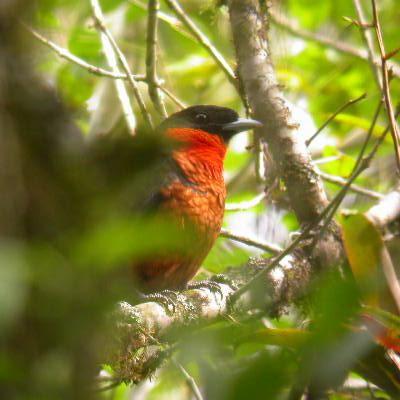 Nearly every year a Central-Colombia tour is organised. The goal of the trip are the endemics.
Safety was of course the highest priority. For this reason we dropped some areas with good endemics.
Nearly every year a Central-Colombia tour is organised. The goal of the trip are the endemics.
Safety was of course the highest priority. For this reason we dropped some areas with good endemics.
It must be said that every year participants are nervous for going to Colombia, but once they are here
for a few days they feel very safe. (Sometimes they feel too safe.)
Although it often rained (start of the rainy season), rain hadn't much influence on the number of birds we saw.
The program was perhaps a bit overloaded, resulting in many species, but sometimes too much stress for the participants.
Participants were all very good birders resulting in 17 endemics! and another 20 specialities!
A total of 398 species were seen in just a fortnight!
Download here the Birdlist of the trip (PDF-file).
Itinerary
3/4/2004, 14:55: arrival of the Dutch participants: Jan-Joost Bouwman and Peter Maaskant. We took immediately
the bus to Tunja and then to Arcabuco, arriving late.
4/4: Waking up and seeing immediately your first endemic - Black Inca (Coeligena prunnelei) -
flying around the house, is always nice. Another good hummingbird, which is common around the house, is
the Short-tailed Emerald (Chlorostilbon poortmani).
We made a walk in the forest nearby for the Rufous-rumped Tapaculo (Scytalopus griseicollis),
which was quickly found.
David Shackelford, who joined us for this day, had to return to Bogota.
In the afternoon we went to a swampy area for Noble Snipe, but suddenly heavy rain stopped all birding.
5/4: In the morning we tried again for the Noble Snipe (Gallinago nobilis).
This time with more luck. A total of 9 birds were seen.
In the afternoon more time was spend around the house to find the range-restricted
Golden-bellied Starfrontlet (Coeligena bonapartei). No luck. Normally it is easy
to see here but probably the works at the house has scared it away.
We returned to Bogota to pick-up the 2 participants from Belgium: Kris De Rouck and Jan Kelchtermans.
Overnight in Bogota.
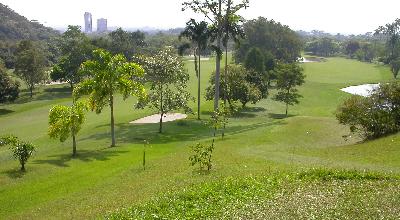 6/4: A morning flight to Cali. Luis Mazariegos waited for us at the airport.
He is one of the best photographers of hummingbirds. I highly recommend his book "Hummingbirds of Colombia".
For me the most beautiful book on bird photography and a must for everyone interested in hummingbirds.
6/4: A morning flight to Cali. Luis Mazariegos waited for us at the airport.
He is one of the best photographers of hummingbirds. I highly recommend his book "Hummingbirds of Colombia".
For me the most beautiful book on bird photography and a must for everyone interested in hummingbirds.
We went first to the Club Campestre of Cali. Notable birds were Bar-crested Antshrike
(Thamnophilus multistriatus), Jet Antbird (Cercomacra nigricans),
the endemic Greyish Piculet (Picumnus granadensis) and some noisy
Little Chachalacas (Ortalis motmot guttata).
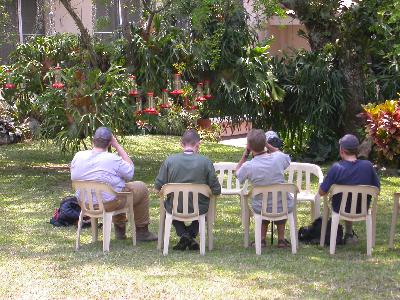 Luis has built plenty of hummingbird feeders at his house. He showed us the difference between the
Black-throated (Anthracothorax nigricollis) and the Green-breasted Mango (A. prevostii).
Luis has built plenty of hummingbird feeders at his house. He showed us the difference between the
Black-throated (Anthracothorax nigricollis) and the Green-breasted Mango (A. prevostii).
A female Ruby-Topaz Hummingbird (Chrysolampis mosquitus) came very quickly and disappeared.
In the afternoon we went to the house of Roberto Oelman at an altitude of 1800 m asl.
He has placed as well hummingbird feeders.
Very impressive! We saw here 17 species of hummingbirds. Among them Purple-throated Woodstar
(Philodice mitchellii) (photo), Long-tailed Sylph (Aglaiocercus kingi),
Long-billed Starthroat (Heliomaster longirostris),
Fawn-breasted Brilliant (Heliodoxa rubinoides),
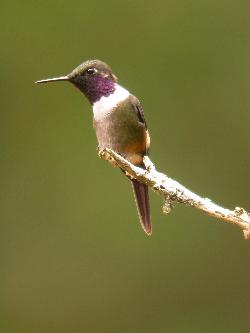 Blue-headed Sapphire (Hylocharis grayi), Brown Violet-ear (Colibri delphinae),
Green (Phaethornis guy) and Tawny-bellied Hermit (P. syrmatophorus).
Blue-headed Sapphire (Hylocharis grayi), Brown Violet-ear (Colibri delphinae),
Green (Phaethornis guy) and Tawny-bellied Hermit (P. syrmatophorus).
We said good-bye to Luis at El 18.
This spot is the best place to see Multicoloured Tanager (Chlorochrysa nitidissima).
And indeed it took us 15 minutes and we had a good mixed flock with a few of them. Beautiful bird.
A Crimson-rumped Toucanet (Aulacorhynchus haematopygus) was calling above us.
Click on the picture for a small AVI-clip (0.6 Mb).
Finally we went by bus to Buga, where we all slept well.
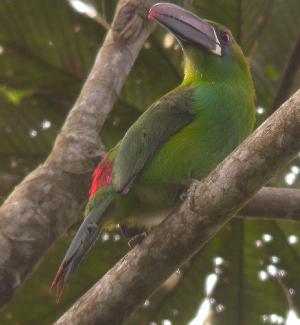 7/4: In the morning we went to Bosque Yotoco. One of the aims was Chestnut-crowned Gnateater
(Conopophaga castaneiceps) and Turquoise Dacnis-Tanager (Pseudodacnis hartlaubi).
But we missed on both this time.
7/4: In the morning we went to Bosque Yotoco. One of the aims was Chestnut-crowned Gnateater
(Conopophaga castaneiceps) and Turquoise Dacnis-Tanager (Pseudodacnis hartlaubi).
But we missed on both this time.
Everyone was still happy to see White-throated Spadebill (Platyrinchus mystaceus),
Cauca Guan (Penelope perspicax) and especially 2 Mottled Owls (Strix virgata).
Crimson-rumped Toucanet (Aulacorhynchus haematopygus) (photo) was seen again.
In the afternoon we drove to Pereira, arriving late in the Otun-Quimbaya NP.
Over the many years I'm travelling and organising tours in Colombia, I never had good experiences with my stays
in the National Parks of Colombia. The management of the park (Ministerio de Medio Ambiente) is a real disaster.
I planned to give them one more chance, but I was again disappointed.
When we arrived, we noticed that they had forgotten to reserve rooms for us.
Even though it was clearly written in their reservation book. This among many other things.
On the other hand private run parks are very good.
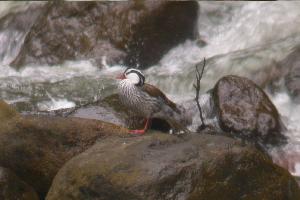 8/4: In the morning we made a small walk on the main road and we quickly saw several Red-ruffed Fruitcrows
(Pyroderus scutatus). For most participants the most beautiful bird of the trip.
8/4: In the morning we made a small walk on the main road and we quickly saw several Red-ruffed Fruitcrows
(Pyroderus scutatus). For most participants the most beautiful bird of the trip.
Other nice birds seen here were: Wattled Guan (Aburria aburri),
Cauca Guan (Penelope perspicax) (again!) and
Multicoloured Tanager (Chlorochrysa nitidissima) (again!).
Torrent Duck (Merganetta armata) (see photo) and
Sharpe's Wrens (Cinnycerthia olivascens) were seen on the way to La Pastora (the visitor centre).
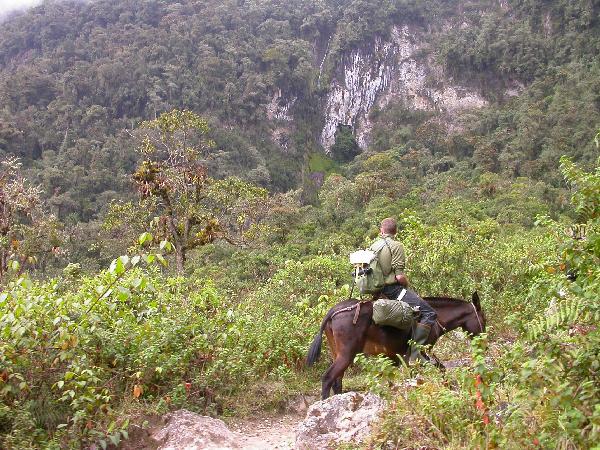 9/4: The people from the GER made an early breakfast for us. We did some birding around the lodge.
This was good for Dusky Piha (Lipaugus fuscocinereus) and Red-hooded Tanager (Piranga rubriceps). Both nice birds
which are not often seen.
9/4: The people from the GER made an early breakfast for us. We did some birding around the lodge.
This was good for Dusky Piha (Lipaugus fuscocinereus) and Red-hooded Tanager (Piranga rubriceps). Both nice birds
which are not often seen.
At around 9 am the horses arrived and we went on horseback to the paramo. We made some stops on the way which resulted in a few
good birds.
We saw our first Grey-breasted Mountain-toucan (Andigena hypoglauca) (only seen by me),
Black-thighed Puffleg (Eriocnemis derbyi) and Purple-backed Thornbill (Ramphomicron microrhynchum).
Chestnut Wood-quail (Odontophorus hyperythrus) was only heard.
At arrival in the paramo some saw Andean Lapwing (Vanellus resplendens) and
Mountain Avocetbill (Opisthoprora euryptera).
The lodge here was a bit primitive, but everyone slept well at an altitude of 3600 m asl.
 10/4: The first thing in the morning was going up to the Avocetbill place. We were lucky and not only saw the Avocetbill
but as well a Bearded Helmetcrest (Oxypogon guerinii) at just 3 meters.
10/4: The first thing in the morning was going up to the Avocetbill place. We were lucky and not only saw the Avocetbill
but as well a Bearded Helmetcrest (Oxypogon guerinii) at just 3 meters.
Flocks of the endemic Rufous-fronted Parakeet (Bolborhynchus ferrugineifrons) were seen on various occasions. But in a hidden
valley were I often see them, there was a flock of 60. Here as well we encountered another
Noble Snipe (Gallinago nobilis) and a female Rainbow-bearded Thornbill (Chalcostigma herrani).
On the way down we saw Viridian (Metallura williami) and
Tyrian Metaltail (M. tyrianthina),
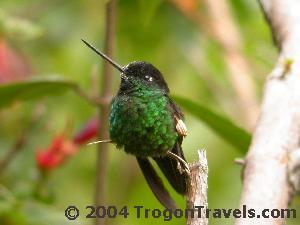 Buff-winged Starfrontlet (Coeligena lutetiae), for Peter the most beautiful hummer,
Grey-breasted (Andigena hypoglauca) and Black-billed Mountain-toucan (A. nigrirostris),
2 Andean Condors (Vultur gryphus) on a ridge,
White-banded Tyrannulet (Mecocerculus stictopterus),
many Red-crested Cotingas (Ampelion rubrocristata),
Black-banded Woodcreeper (Dendrocolaptes picumnus),
Powerful Woodpecker (Campephilus pollens),
Black-headed Hemispingus (Hemispingus verticalis),
Buff-breasted Mountain-tanager (Dubusia taeniata) and many Brush-Finches.
When we arrived in the afternoon at the lodge, the days total was 70 species.
Buff-winged Starfrontlet (Coeligena lutetiae), for Peter the most beautiful hummer,
Grey-breasted (Andigena hypoglauca) and Black-billed Mountain-toucan (A. nigrirostris),
2 Andean Condors (Vultur gryphus) on a ridge,
White-banded Tyrannulet (Mecocerculus stictopterus),
many Red-crested Cotingas (Ampelion rubrocristata),
Black-banded Woodcreeper (Dendrocolaptes picumnus),
Powerful Woodpecker (Campephilus pollens),
Black-headed Hemispingus (Hemispingus verticalis),
Buff-breasted Mountain-tanager (Dubusia taeniata) and many Brush-Finches.
When we arrived in the afternoon at the lodge, the days total was 70 species.
11/4: We left early in the morning for the trail between La Pastora and El Cedral.
I was the only who saw the nice Chestnut-breasted Wren (Cyphorhinus thoracicus).
Moustached Antpitta (Grallaria alleni) was only heard. His call came from beneath a steep ravine.
What me reminded most of this day were the 2 imm. Green-fronted Lancebills (Doryfera ludovicae) who
were sitting close to each other and were fed regularly by their mother. Sometimes their long bill crossed
each other as if their were fighting with swords. A pity that light was very poor for taking photos.
Greenish Puffleg (Haplophaedia aureliae) was the only hummer I expected to see and at the last moment we saw him. This means that we
nearly saw all hummers that occur in the park (22 species). Only Sword-billed (Ensifera ensifera), that I once saw, wasn't seen.
One of the last birds of Ucumari NP were 5 White-capped Tanagers (Sericossypha albocristata). Nice birds to finish this part of the trip.
We went back to Pereira. Acorn Woodpecker (Melanerpes formicivorus) was seen in the centre of the Pereira near the bus terminal !!
We drove to Apia, where we stayed in a small hotel.
12/4: Just a few days ago there has been troubles on the road Apia - Pueblo Rico. Therefore police wasn't happy
that we went that way.
But after some talks over the phone with the highest authorities of Risaralda,
we were allowed to go, on the condition that we reported us at the police office of Apia and Pueblo Rico.
At arrival in the reserve we had again Multicoloured Tanagers (Chlorochrysa nitidissima) in a mixed flock.
Jan-Joost and I found quickly the bird of the reserve: Black-&-gold Tanager (Bangsia melanochlamys)!!
The others had to wait a day.
It must be said: it was hard birding as trails were very muddy. Other birds seen in the afternoon were: Band-tailed Barbthroat (Threnetes ruckeri),
Western Long-tailed Hermit (Phaethornis longirostris), Golden-breasted Puffleg (Eriocnemis mosquera) (only by Jan),
Purplish-mantled Tanager (Iridosornis porphyrocephala) and Brown-billed Scythebill (Campylorhamphus pusillus)
(last 2 only by Peter).
Scalloped Antthrush (Chamaeza turdina) could only be heard, but a Tapaculo (prob.
Nariño Tapaculo (Scytalopus sp.)) could easily be seen. The easiest tapaculo I have ever seen.
 13/4: In the morning we started the long triangular walk to Karagabi, the entrance and back.
13/4: In the morning we started the long triangular walk to Karagabi, the entrance and back.
Highland Tinamou (Nothocercus bonapartei) was just sitting on the trail, but only I saw it well.
Beautiful Jays (Cyanolyca pulchra) were found but also badly seen. It is a pity beacuse they are indeed beautiful.
Although it started raining heavily birds were still active. On a branch there was a
Rufous-crested Tanager (Creurgops verticalis) and a bit later I found a group of endemic
Crested Ant-tanagers (Habia cristata).
It took me a while to catch the rest of the group, who didn't hear me yelling with the
noise of the creek and the rain. Finally we got back and could find them again. Just at a few meters away from us.
Jan really wanted to see the red variety of the Andean Cock-of-the-Rock (Rupicola peruviana)
but we didn't have the time to wait for the lek at 4 pm.
We tried often to lure out the Yellow-breasted Antpitta (Grallaria flavotincta), but it was only Jan-Joost who saw it
when it crossed the trail on our way out.
Mules brought our gear back half-way the trail where the jeep was waiting. Then to Apia and from here to Manizales.
We stayed in a hotel in the city centre.
14/4: Taxis drove us up to the reserve. After arrival we started birding immediately. Good mixed flocks with
Black-eared Hemispingus (Hemispingus melanotis), Grey-hooded Bush-tanager (Cnemoscopus rubrirostris)
and Plushcap (Catamblyrhynchus diadema). These 3 species we hadn't seen in Ucumari NP.
We saw 2 Stripe-headed Brush-finches (Buarremon torquatus) looking for food on the aquaduct trail.
A bit further a Rusty-faced Parrot (Hapalopsittaca amazonina) was on his nest.
He flew off before the others arrived, but the next day Jan and Kris sawa group feeding.
We tried long to call in a Undulated Antpitta (Grallaria squamigera), but he didn't want to come closer.
We returned back to the headquarters. The day list was made with 9 species of hummingbirds hovering around us.
At night we heard Rufous-banded Owl (Strix albitarsus).
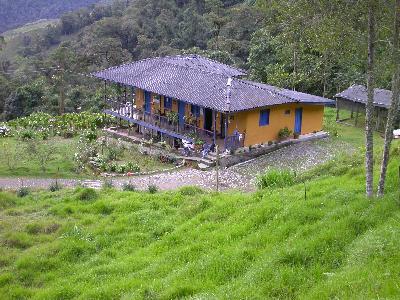 15/4: A couple of Highland Motmot (Momotus aequatorialis) were the first birds we saw when we woke up.
They were eating the beetles who flew towards the lights of the cabañas at night.
(They sometimes even try - and succeed - to catch a hummingbird at the feeders.)
15/4: A couple of Highland Motmot (Momotus aequatorialis) were the first birds we saw when we woke up.
They were eating the beetles who flew towards the lights of the cabañas at night.
(They sometimes even try - and succeed - to catch a hummingbird at the feeders.)
Sergio - the director of the reserve - joined us for today. It resulted in a good list.
Following birds were seen well:
Yellow-vented Woodpecker (Veniliornis dignus), tapping for a long period and he could be digiscoped,
Golden-plumed Parakeet (Leptosittaca branickii), (We were very lucky that they just landed in a high tree in front of us),
Rufous-headed Pygmy-tyrant (Pseudotriccus ruficeps) and Rufous-crowned Tody-tyrant (Poecilotriccus ruficeps),
Slate-crowned Antpitta (Grallaricula nana),
Long-tailed Antbird (Drymophila caudata) high in a tree,
Tyrannine Woodcreeper (Dendrocincla tyrannina) in mixed flock,
Unicoloured (Scytalopus unicolor latrans) and Spillmann's Tapaculo (S. spillmanni),
Mountain (Cacicus chrysonotus) and Yellow-billed Cacique (Amblycercus holosericeus)
(Last one only seen by Sergio.) and ...
Masked Saltator (Saltator cinctus) (Definitely the best bird but unfortunately only seen by Kris and Jan).
Andean Pygmy-owl (Glaucidium jardinii) was heard closeby, but he didn't want to come close enough for a good view.
In the afternoon we drove to Medellin.
16/4: Juan David Ramirez joined us for the next days. He brought us to an area closeby Medellin,
which is good for the endemic Red-bellied Grackle (Hypopyrrhus pyrohypogaster).
Usually we find it very quickly here, but this time it took us a long time.
Must be said that it was very quiet and we didn't hear or see many other birds.
On the way to Rio Claro, we made a stop in El Viao. We were escorded by 2 heavy armed militars. Normally a good
site but in the middle of the day the only special bird we saw was an
Ochre-breasted Tanager (Chlorothraupis stolzmanni).
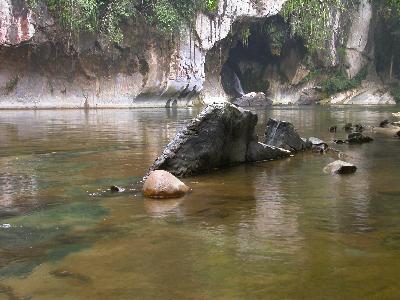 We arrived in Rio Claro and the marble river was very clear and is then very impressing.
We arrived in Rio Claro and the marble river was very clear and is then very impressing.
A Fasciated Tiger-heron (Tigrisoma fasciatum) was fishing in it.
Chestnut-headed Oropendolas (Psarocolius wagleri) built there nests above the restaurant.
Towards the evening we went to the Oilbird (Steatornis caripensis) cave (see photo).
First a few came out but soon more and more were leaving the cave.
A Green-fronted Lancebill (Doryfera ludovicae) was catching insects from a boulder in front of the cave.
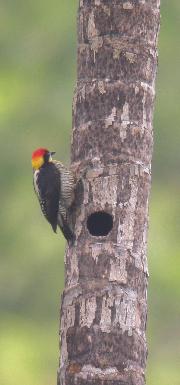 17/4: From our lodge who was nicely placed along the river we could see in the morning
Collared Arassaris (Pteroglossus torquatus) and a Broad-billed Motmot
(Electron platyrhynchum) at eye-level.
17/4: From our lodge who was nicely placed along the river we could see in the morning
Collared Arassaris (Pteroglossus torquatus) and a Broad-billed Motmot
(Electron platyrhynchum) at eye-level.
While we were waiting for breakfast at the restaurant, we made a small walk on the main road.
Little Tinamou (Crypturellus soui) was walking near the path. Jan went after the
Southern Nightingale-wren (Microcerculus marginatus) and found it.
After breakfast we went to the Condor Cave. The first 300 meters of forest were completely cleared.
A couple of Beautiful Woodpeckers (Melanerpes (chrysauchen) pulcher) were making their nest
in one of the lonely dead palms that were still standing (see photo).
In the forest we found reasonably fast Antioquia Bristle-tyrant (Phylloscartes lanyoni) as well as
Brownish Twistwing (Cnipodectes subbrunneus) and Black-faced Antthrush (Formicarius analis).
In a mixed flock with One-coloured Becard (Pachyramphus homochrous), Peter and Jan-Joost discovered in it as well a
Sooty Ant-tanager (Habia gutturalis) (endemic).
On the way back some time was spend at a lek of White-bearded Manakins (Manacus manacus).
At the end of the trail there was a Cinnamon Woodpecker (Celeus loricatus) seen in a high tree.
At noon I found a female Fasciated Antshrike (Cymbilaimus lineatus) along the road and a
King Vulture (Sarcoramphus papa) flying quite high.
On the El Refugio trail there were Chestnut-backed (Myrmeciza exsul),
Dull-mantled (M. laemosticta) and Bicoloured Antbirds (Gymnopithys bicolor) at army ants.
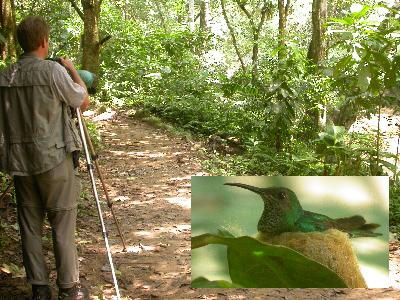 Jan found a White-mantled Barbet (Capito hypoleucus) high in a tree. Nearly everyone had good views
of this "highly wanted" bird, but we often asked ourselves how he found it. He alone also saw
White-ruffed Manakin (Corapipo altera).
Jan found a White-mantled Barbet (Capito hypoleucus) high in a tree. Nearly everyone had good views
of this "highly wanted" bird, but we often asked ourselves how he found it. He alone also saw
White-ruffed Manakin (Corapipo altera).
2 Barred Puffbirds (Nystalus radiatus) were sitting on a power line.
Near our lodge there was a nest of a White-necked Jacobin (Florisuga mellivora),
just a meter from the trail (see photo).
18/4: While waiting for breakfast we saw Blue-chested Hummingbird (Amazilia amabilis).
Jan found a species of Nighthawk (Chordeiles sp.), which was most likely
Lesser Nighthawk (Chordeiles minor).
We walked again to the Condor cave in the hope to get the Ant-tanager again, but in vain.
We could only add to the list a group of endemic Silvery-brown Bare-face Tamarins
(Saguinus leucopus) and Peter and Juan David saw a Citron-throated Toucan (Ramphastos citreolaemus).
On the main trail we got Orange-billed Sparrow (Arremon aurantiirostris)
and some Tanagers as Tawny-crested (Tachyphonus delatrii), White-shouldered (T. luctuosus)
and the noisy Dusky-faced (Mitrospingus cassinii).
While waiting for the bus, I spotted a Lesser Elaenia (Elaenia chiriquensis) on a wire.
We arrived in the evening in Bogota.
19/4: We brought Kris and Jan to the airport and went then straight to parque La Florida.
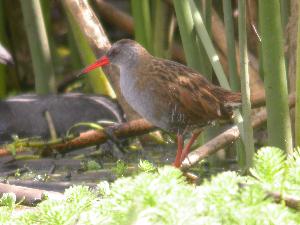 It didn't take long to see and digiscope Bogota Rail (Rallus semiplumbeus). Also we had here
Spot-flanked Gallinule (Gallinula melanops), a Masked Duck (Nomonyx dominica)
and a Fulvous Whistling-duck (Dendrocygna bicolor).
It didn't take long to see and digiscope Bogota Rail (Rallus semiplumbeus). Also we had here
Spot-flanked Gallinule (Gallinula melanops), a Masked Duck (Nomonyx dominica)
and a Fulvous Whistling-duck (Dendrocygna bicolor).
We visited as well the La Conejera Humedal and saw there the endemic
Silvery-throated Spinetail (Synallaxis subpudica).
20/4: We woke up at Laguna Fuquene and were pleased to see Spot-flanked Gallinules
(Gallinula melanops) swimming underneath us. There was as well a Least Bittern
(Ixobrychus exilis) fishing.
During the walk we encountered a group of Apolinar's Wrens (Cistothorus apolinari).
Peter definitely wanted to find the last endemic of the area: Rufous-browed Conebill (Conirostrum rufum).
He finally got him.
The paramo was very dry, but we gave it a try. Apart from the last bird, nothing was seen.
We all went to the airport and Jan-Joost and Peter had their flight to Holland.
Acknowledgments
This trip wouldn't be possible or wouldn't have so good without the help of many people.
I like to thank following persons:
Roberto Chavarro Chavarro and his lovely wife Ginette for the stay in Arcabuco.
Luis Mazariegos, who took us around in his van and taught us many things about hummers.
Roberto Oelman, who gave us permission to visit the hummers at his house,
Sergio Ocampo, director of the Rio Blanco reserve. He guided us in Rio Blanco.
The people from the GER (Grupo Ecologico de Risaralda) for the whole organisation in the Ucumari NP.
The fundacion Madremonte in Bogota for their hospitality and help in the Providencia reserve (Pueblo Rico, Risaralda).
Pablo Flores (ProAves) for the valuable information (esp. on safety),
Loreta Rosselli for the information on esp. Laguna Fuquene,
Juan David Ramirez for guiding and transporting us between Medellin and Rio Claro.
I especially like to thank the police and the army for the support they gave us during the trip.
Finally I like to thank all participants (Jan-Joost, Peter, Jan and Kris). Sometimes they endured hard
conditions, such as the accommodation in the paramo and Pueblo Rico, the heavy rain (esp. in Arcabuco),
the many muddy trails in the reserve in Pueblo Rico and the hardest moment ...
when they had to wait for a breakfast in the paramo at a time that there were so
many nice birds waiting to be seen.
Thanks to their good eyes and ears, we could add many excellent species.
Jurgen Beckers
All pictures were taken during the trip and are copyrighted (© 2004 Jurgen Beckers).

Top of Page
|
